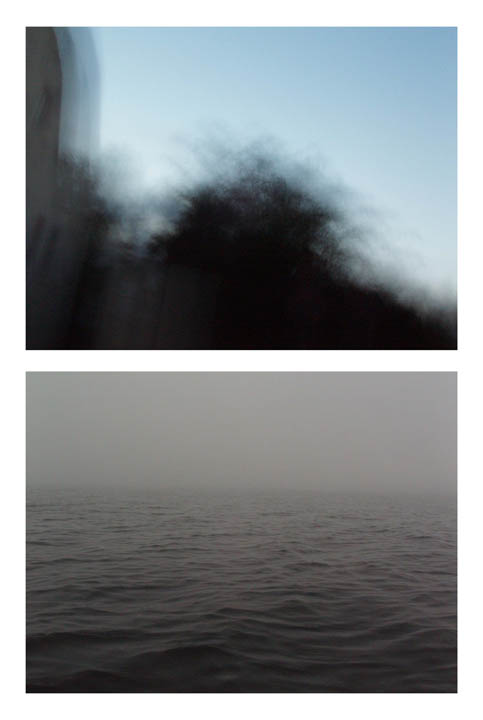
Mirage, 2006, Digital pigment prints.
Mirage: A visual phenomenon that occurs with alternating layers of warm and cool air near the ground or water surface. Instead of traveling straight through the air, light is bent towards the cooler denser air resulting in a complicated path that evinces a strange distant object. This mirage is actually a superposition of several images of one object and may undergo rapid changes as the air layers move up or down relative to the observer.
I am walking down the street past a fence. It has barbed wire along the top of it. I reach a section where there are heaps of plastic that have blown into the barbed wire and are now tangled in it—long strands of it, and it’s windy. The plastic in the wind becomes something else, something other than just plastic in the wind. The plastic is blowing like hair. The plastic in the wind becomes hair. Now I’m in a bathroom washing my hands. I look down into the sink and see a small crack that runs about eight inches. It recedes over the edge of the sink and into the dark background. It punctuates the round curve of the shape of the sink which sits in darkness. The sink and its characteristics, its neighboring elements become something else while I continue to look—a trace of movement, a breach of solidity. I am now in the back seat of a car at night riding south on the FDR. It’s dark except for the city lights. On the door, dark green leather upholstery stands in relief to the night. I sit and consider my proximity to it. It’s late and my eyes are aware that it begins to resemble a landscape, textured and backlit by mercury vapor, vibrating as we drive. The leather is no longer leather.
I have seen these things—plastic, bathroom sinks, leather upholstery—and know of their existence, their place in a world I share with them. I understand their function, their use-value. But there are moments when these familiar things become transformed and it’s as if I’m seeing them for the first time, as if I become untethered from the everyday and float into a chaos where things are created only as they are apprehended by a viewer. Is memory to blame for this? A mirage becomes a meditation on seeing, it’s qualities of form having less to do with illusion than that of medium, ie. on the flow of things in the world in their constant jostle and movement as they bump into each other and affect each other and how that flow occasionally finds its way within our sights. Viewer participation—everyone brimming with memories and reflections, the weight of specificity—directly affects the way light particles ultimately reach us. A mirage shows us that seeing is really a continual discovery of the relationship between the past and the present. Seeing is being an involved observer within a matrix of emanations from objects and projections of meaning of our own—whether conscious or not—onto those objects.
Mirage is a project that considers these principles of light and perception in relation to memory. In this work, the physical reality of a mirage, layering of cool and warm air, commingles with perceptual manifestations, ie. light that either refracts (experienced as projections of meaning of our own onto objects) or reflects (experienced as emanations from objects), suggesting the complexity of a structure that appears to us as a thing. Mirage consists of vertical diptychs which contrast a variety of images: car seats, bathroom sinks, plastic tangled in barb wire, and dead fish with images that are less figurative, more abstract and suggestive of a particular quality that is present in the figure portion of the diptych. By placing these two different kinds of images in proximity to each other, I am interested in seeing how we traverse the expanse from chaos to recognition, a passage that echoes our own struggle for existence from nowhere. The dualism embodied by our seeing is related to another dualism—body and spirit—likewise, these two poles creating an expanse that fuels acts of propitiation for each aspect resulting in a profound awareness of our own mortality. All images pictured are: Untitled, digital pigment print, 13 x 20".
